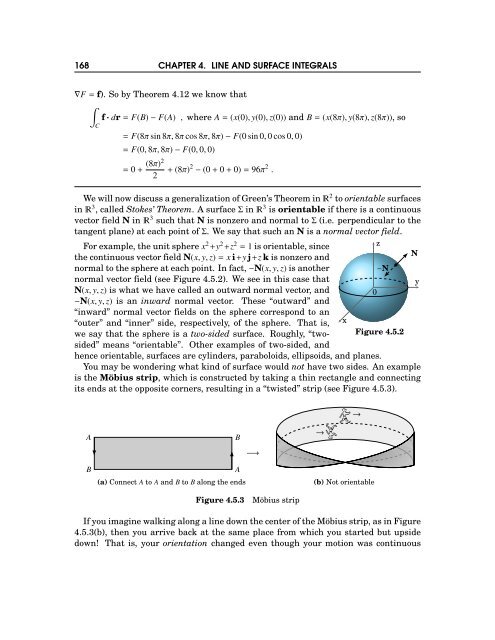Michael Corral: Vector Calculus
Michael Corral: Vector Calculus
Michael Corral: Vector Calculus
You also want an ePaper? Increase the reach of your titles
YUMPU automatically turns print PDFs into web optimized ePapers that Google loves.
168 CHAPTER 4. LINE AND SURFACE INTEGRALS<br />
∇F= f). So by Theorem 4.12 we know that<br />
∫<br />
f·dr=F(B)−F(A) , where A=(x(0),y(0),z(0)) and B=(x(8π),y(8π),z(8π)), so<br />
C<br />
= F(8πsin8π,8πcos8π,8π)−F(0sin0,0cos0,0)<br />
= F(0,8π,8π)−F(0,0,0)<br />
= 0+ (8π)2<br />
2<br />
+(8π) 2 −(0+0+0)=96π 2 .<br />
WewillnowdiscussageneralizationofGreen’sTheoremin 2 toorientablesurfaces<br />
in 3 , called Stokes’ Theorem. A surfaceΣin 3 is orientable if there is a continuous<br />
vector field N in 3 such that N is nonzero and normal toΣ(i.e. perpendicular to the<br />
tangent plane) at each point ofΣ. We say that such an N is a normal vector field.<br />
Forexample,theunitsphere x 2 +y 2 +z 2 = 1isorientable,since z<br />
N<br />
thecontinuousvectorfieldN(x,y,z)= xi+yj+zkisnonzeroand<br />
normaltothesphereateachpoint. Infact,−N(x,y,z)isanother −N<br />
normal vector field (see Figure 4.5.2). We see in this case that<br />
y<br />
N(x,y,z) is what we have called an outward normal vector, and 0<br />
−N(x,y,z) is an inward normal vector. These “outward” and<br />
“inward” normal vector fields on the sphere correspond to an<br />
“outer” and “inner” side, respectively, of the sphere. That is, x<br />
we say that the sphere is a two-sided surface. Roughly, “twosided”<br />
means “orientable”. Other examples of two-sided, and<br />
Figure 4.5.2<br />
hence orientable, surfaces are cylinders, paraboloids, ellipsoids, and planes.<br />
You may be wondering what kind of surface would not have two sides. An example<br />
is the Möbius strip, which is constructed by taking a thin rectangle and connecting<br />
its ends at the opposite corners, resulting in a “twisted” strip (see Figure 4.5.3).<br />
A<br />
B<br />
(a) Connect A to A and B to B along the ends<br />
B<br />
A<br />
−→<br />
AA →<br />
→<br />
(b) Not orientable<br />
Figure 4.5.3 Möbius strip<br />
IfyouimaginewalkingalongalinedownthecenteroftheMöbiusstrip,asinFigure<br />
4.5.3(b), then you arrive back at the same place from which you started but upside<br />
down! That is, your orientation changed even though your motion was continuous








